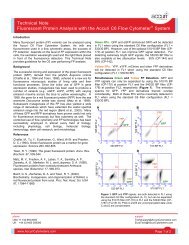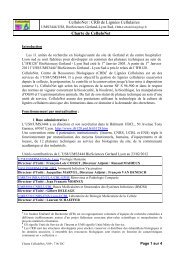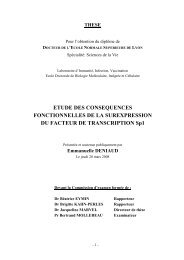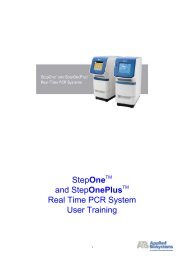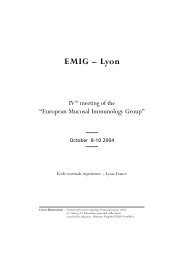SOUCHES AFRICAINES DU VIRUS DE LA ROUGEOLE : ETUDE ...
SOUCHES AFRICAINES DU VIRUS DE LA ROUGEOLE : ETUDE ...
SOUCHES AFRICAINES DU VIRUS DE LA ROUGEOLE : ETUDE ...
You also want an ePaper? Increase the reach of your titles
YUMPU automatically turns print PDFs into web optimized ePapers that Google loves.
ABSTRACT<br />
Africa remains one of the major reservoirs of measles infection. Molecular<br />
epidemiological studies have permitted different measles virus isolates to be grouped into<br />
clades and genotypes and the major group which has been identifed as indigenous to Africa is<br />
the clade B. We have analysed the viruses from epidemics in the Gambia (1993) and in the<br />
Cameroon (2001). In both studies, the homogeneity of the virus isolates within the epidemic<br />
as shown by sequence analysis revealed less than 0.2% variation of nucleotides between<br />
isolates. The measles viruses isolated in 1983 in Yaoundé, Cameroon, were designated as the<br />
B1 genotype. However, in 2001 only viruses belonging to the B3 genotype were found in this<br />
city. The viruses in the Gambia (1993) were also of the B3 genotype. However, these viruses<br />
could be distinguished from each other at the antigenic level and by comparative sequence<br />
analysis. The B3 Cameroon (2001) viruses were related to the proposed B3.1 subgroup,<br />
whereas the Gambian (1993) isolates corresponded to the B3.2 subgroup. The geographical<br />
distribution for the period 1993-2001 of these two viruses shows that B3.1 is found from the<br />
Sudan to Nigeria and Ghana extending south to the Cameroon, whereas the B3.2 genotype is<br />
found in West Africa. In Nigeria and Ghana the viruses co-circulate. The identification of<br />
these viruses will permit more meaningful epidemiological studies following the proposed<br />
increased measles vaccination coverage.<br />
INTRO<strong>DU</strong>CTION<br />
Epidemiological studies are essential for the successful planning and application of<br />
vaccination programs. The aim may be simply to reduce the disease burden or target<br />
eradication. Measles ranks as one of the most infectious diseases and although a vaccine<br />
exists for more than 30 years, measles is still responsible for the deaths of approximately 1<br />
million children each year. Under optimum conditions the vaccine has a sero-conversion rate<br />
of over 95%, but this is lower in children under 12 months of age due to the immaturity of the<br />
immune system and the presence of maternal antibody (Gans et al., 1998). Although natural<br />
infection gives a life-long immunity, vaccination has been shown to induce lower immune<br />
responses (Markowitz et al, 1990) and there are a number of reports showing subsequent<br />
infection when confronted by circulating measles viruses (Edmonson et al., 1990 ; Gustafson<br />
et al., 1987 ; Mathias et al., 1989 ; Pedersen et al., 1989 ; Whittle et al., 1999). These may<br />
range from silent infections to clinically diagnosed measles. Despite these reservations,<br />
intensive vaccination campaigns in the South American continent eliminated the endogenous<br />
virus (de Quadros et al., 1996). However, it is probable that re-introduction from outside was<br />
the source of further epidemics in Brazil (Siqueira et al., 2001).<br />
Measles virus is considered to be a single serotype. Over the past 20 years a number of<br />
virus isolates have been obtained from geographically distinct regions (Rima et al., 1995 ;<br />
Rota et al., 1996). Nucleotide sequence analysis of the different viral genes has shown that<br />
most variation is found in the haemagglutinin (HA) and the carboxy region of the<br />
nucleoprotein (NP). Sequence analysis of these two viral genes from different viruses has<br />
provided a classification in which isolates are separated into 8 clades (A-H) each containing<br />
variants or genotypes (WHO, 1998). This molecular epidemiological approach enables the<br />
origins of the measles viruses to be traced.<br />
Only limited information is available on the stability of measles viruses within and<br />
between epidemics. Further the increase in vaccine coverage may impose an immunoselection<br />
on the circulating viruses. El Mulbarak et al. (2002) have shown very little sequence<br />
variation in the HA (0-0.5%) in measles viruses isolated in the Sudan between 1997-2000. In<br />
contrast, Hanses et al. (1999) suggested that there were two measles virus strains cocirculating<br />
in epidemics in Nigeria and Ghana in 1998.<br />
97










